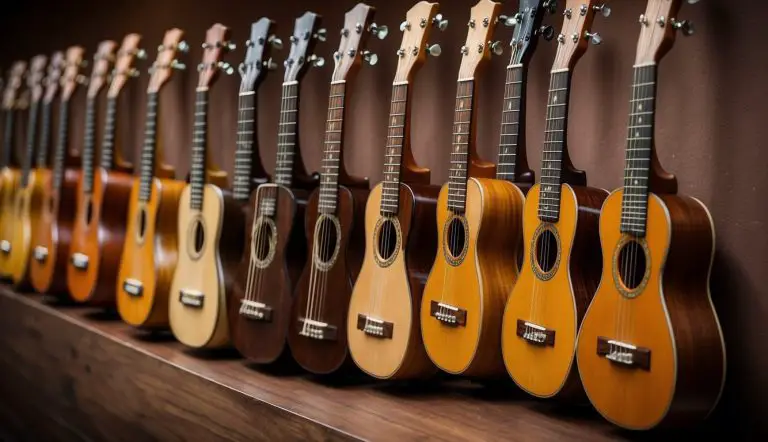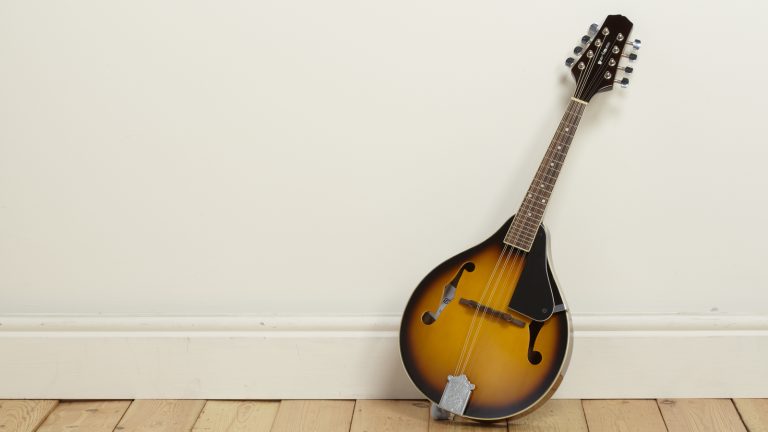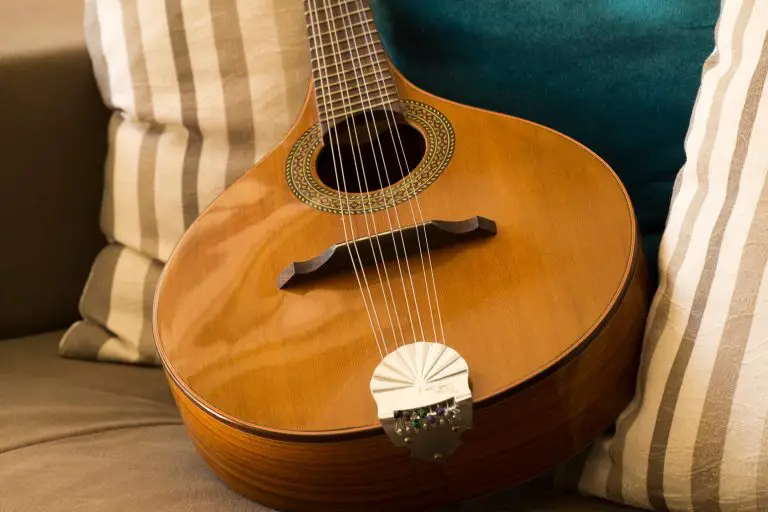Should I Learn The Mandolin Or The Ukulele?
Folkstrings.com is reader-supported. When you buy through links on our site, we may earn a small commission.
Table of Contents
- What are the Main Differences Between the Ukulele and the Mandolin?
- Are Ukulele and Mandolin Chords the Same?
- Which Is Easier to Learn Ukulele or Mandolin?
- Conclusion – Should I Learn the Mandolin Or The Ukulele?
Many people wonder, should I learn the Mandolin or the Ukulele. Mandolins and Ukuleles are both stringed instruments that come from the lute family.
Lutes are stringed instruments with half egg-shaped bodies and long necks.
Because both the ukulele and mandolin come from the same family of instruments, they are often mistakenly believed to be very similar, though they are quite different.
The strings of a mandolin and ukulele are both plucked and can be strummed, but they are made of different materials and one is more difficult to play than the other.
Beginners should consider the similarities and differences between the two instruments before deciding which one to work towards mastering.
What are the Main Differences Between the Ukulele and the Mandolin?

Although there are likenesses between the two instruments, there are also some components that make them entirely different.
The following offers information on the aspects that allow musicians to better identify the differences between a mandolin and a ukulele.
Overall Differences
Mandolins can be plucked or strummed. They come from the mandore, which is a soprano member of the common lute family.
A ukulele is a plucked chordophone instrument. Ukuleles are considered a subcategory of guitars.
Although both of these instruments stem from the lute family, most musicians agree the mandolin looks more the part than the ukulele, which takes its shape from the guitar.
Strings
Another key area where mandolins and ukuleles differ is the strings.
Today’s modern mandolins are typically constructed with four pairs of metal strings, which means eight strings in all.
Musicians pluck these strings with a device called a plectrum.
Ukuleles, on the other hand, feature four Nylon strings. These are often called gut strings or may be referred to as four courses of strings.
Ukuleles are plucked, using the right index finger.
Construction
Mandolins are made with hollow, wooden bodies. The body is the most important part of the instrument because this is where the sound is produced.
The type of wood used to manufacture a mandolin is important for sound and will control the instrument’s price.
The body consists of the following parts.
· The soundboard is at the top of the body and is typically made of spruce.
· The sound holes are used to allow the music to come out from the hollow body.
· The scroll is only included on F-type mandolins and is mainly for decoration, though it can impact the sound.
· The points are for decoration and allow musicians to better hold their mandolins.
· The pickguard is optional but helps to protect the mandolin body from becoming damaged with strumming.
· The wooden bridge lines up the strings and holds them in place.
· The tailpiece is decorative but also helps to attach the strings.
The neck consists of a fretboard, frets, fret markers, and the Florida, which helps the mandolin reach a higher pitch.
The headstock holds the tuners and the nut, allowing musicians to tune their mandolins properly before playing.
Ukuleles are made of both wood and plastic, depending on the style.
Like mandolins, ukuleles are made with hollow bodies that help to produce sound.
Ukuleles may be produced in the classical ukulele shape, but in recent years have come to take on many shapes, including cut-away body types.
The body of the ukulele has the following components.
· The sound hole is a large hole featured in the center of the body. This allows the sound to escape. If you strum a ukulele directly over the sound hole, the sound is going to be much louder.
· The neck of a ukulele is curved, allowing musicians to cup their fingers around the fretboard. Ukulele necks are primarily made of wood, but may also be made of plastic.
· The bridge attaches the strings to the ukulele and keeps them separated.
· The saddle raises the strings to the correct height, so their tones sound as they should.
· The headstock holds the tuners, allowing musicians to tune their instruments before playing.
Musical Genres
Although there is no steadfast rule for which musical instruments should be played with certain genres, each instrument is known for being played in certain types of music.
Mandolins are used in classical, folk-rock, ragtime, and bluegrass, though you may occasionally hear them in other genres.
Ukuleles are primarily heard in the musical genres of folk, novelty, and specialty music.
Age
Another difference between the two instruments is their age. Mandolins were invented in Naples, in the 18th century. Ukuleles were invented in Hawaii and did not step into the music scene until the 19th century.
Are Ukulele and Mandolin Chords the Same?
One of the most commonly asked questions regarding mandolins and ukuleles is the chords.
New musicians want to know if the same chords can be played on both instruments.
Musicians who play guitar will find the chords to be the same for the ukulele.
This is why many guitar players naturally pick up the ukulele and are successful at playing, and vice versa.
Because of the number of strings, the chords are different for ukuleles and mandolins.
Most experts agree it is wise to try one instrument or the other instead of attempting to learn them both at the same time since this cuts down on the confusion.
Sometimes, musicians have used chords that mimic the sound of the mandolin on a ukulele.
Although the chord configuration may have some similarities, musicians cannot use the same chords interchangeably for both instruments.
Which Is Easier to Learn Ukulele or Mandolin?
Although some musicians would disagree, generally speaking, ukuleles are easier to learn than mandolins, especially for beginner musicians.
The primary reason for mandolins being more difficult to learn is the strings.
The Strings
Mandolins have eight strings, while ukuleles have four. Mandolins also have metal strings, whereas a ukulele has Nylon.
One of the biggest problems new mandolin players have is with the strings. It takes much more pressure to push in the strings on a mandolin. Many new mandolin musicians find playing their instruments a little painful at first, at least until they have built up some solid calluses.
Ease of Play
When it comes to ease of play, the ukulele is the winner. The strings of a ukulele are Nylon, so they do not bruise the fingertips so badly. They are also lighter, so musicians can more easily press them.
Playing mandolin takes great skill, and it is not an instrument that can be picked up and quickly learned. Mandolin music requires an intuitive approach. The music made for mandolin is typically much more complex than the simple tunes that can be plucked or strummed on a ukulele.
Beautiful Instruments
Both are beautiful instruments in their own ways, and it would be difficult to choose one over the other. Those who are searching for an instrument that can be picked up and played fairly easily should choose the ukulele.
On the other hand, if you prefer a bit of a challenge and are ready for long practices and sore fingers, the mandolin is an exquisite instrument with unique tones, and it is satisfying to learn to play.
Try Them Both
Before considering either instrument, it is wise to try each of them.
Consider the way they feel in your hands. Think about the type of music you enjoy playing.
If you lean more to the classical side, the mandolin offers beautiful music when played.
Musicians who prefer specialty and folk music are going to be interested in learning the ukulele.
Yes, some musicians are fluent in playing both instruments, but they likely did not learn to play them at the same time.
The mandolin takes a focused dedication and plenty of practice.
The ukulele is considered more of a casual instrument that does not always require ongoing study.
Conclusion – Should I Learn the Mandolin Or The Ukulele?
Now, you know a lot more about ukuleles and mandolins and what makes them so different from one another.
In your quest to decide which instrument to take up, it is important to research and understand what each requires.
The biggest differences between mandolins and ukuleles are the strings, sound holes, and shapes.
A mandolin has eight strings, two sound holes, and is rounder in shape. A ukulele has four strings, one sound hole, and is shaped more like a guitar.
No matter which instrument you choose, dedicate yourself to consistent practice, and learn to master the beauty each offers.
Both instruments can sing to you in unique ways, depending on the style of music you prefer playing. With time and experience, you may find you eventually want to learn to play both.
Author Profile
-
Daniel Johnstone is an English writer with a love for stringed instruments from around the world.
He shares his love for these instruments through his writing for folkstrings.com, a website dedicated to all things related to folk string music.
Daniel's passion for music started at a young age, and he has since become an accomplished musician, playing guitar, cavaco, and recently, the harp.
His dedication to learning and sharing his knowledge of stringed instruments is evident in his insightful and engaging blog posts. Whether you're a seasoned musician or a beginner, Daniel's writing is sure to inspire and entertain you.
When he's not playing music or writing, you can find Daniel exploring new instruments and seeking out new sounds to share with his readers.
Latest entries
 AutoharpApril 4, 2024What Is the Autoharp Made Of: Exploring Its Materials and Craftsmanship
AutoharpApril 4, 2024What Is the Autoharp Made Of: Exploring Its Materials and Craftsmanship AutoharpApril 4, 2024Is Autoharp Easy to Play? Unveiling the Truth for Beginners
AutoharpApril 4, 2024Is Autoharp Easy to Play? Unveiling the Truth for Beginners AutoharpApril 4, 2024What Is an Autoharp Worth? Your Guide to Pricing and Value
AutoharpApril 4, 2024What Is an Autoharp Worth? Your Guide to Pricing and Value AutoharpApril 4, 2024Are Autoharp and Zither the Same Thing? Unraveling String Instrument Myths
AutoharpApril 4, 2024Are Autoharp and Zither the Same Thing? Unraveling String Instrument Myths
Affiliates:
This post may contain affiliate links that at no additional cost to you, the site may earn a small commission. We only recommend products we would use ourselves and all opinions expressed on this site are our own.
Accuracy Advice:
While we strive to provide up-to-date and accurate information, the content in this article may not reflect the most current research or medical guidelines. We encourage readers to do further research and consult with professionals for more personalized advice.
Our Recommendations:
The products and services mentioned in any of our articles are recommended based on our independent research and personal experience. We are not sponsored by any company. We aim to suggest products and services we believe are of high quality and could be beneficial to our readers.








